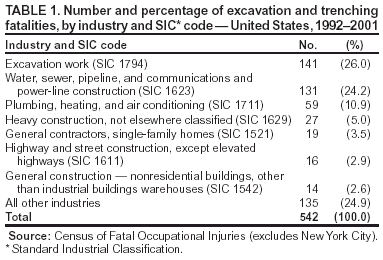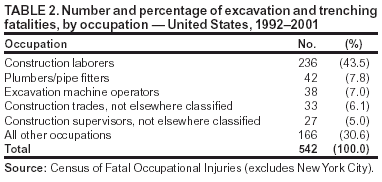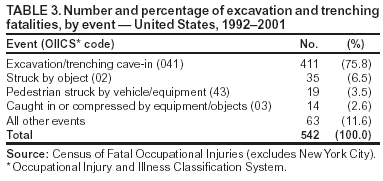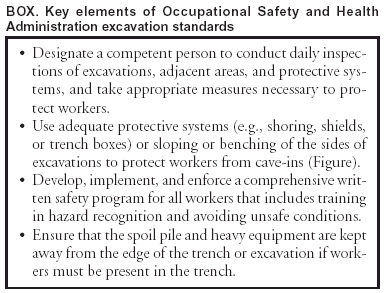 |
|
|
|
|
|
|
| ||||||||||
|
|
|
|
|
|
|
||||
| ||||||||||
|
|
|
|
|
Persons using assistive technology might not be able to fully access information in this file. For assistance, please send e-mail to: mmwrq@cdc.gov. Type 508 Accommodation and the title of the report in the subject line of e-mail. Occupational Fatalities During Trenching and Excavation Work --- United States, 1992--2001Fatalities associated with trench collapses and other excavation hazards continue to occur despite Occupational Safety and Health Administration (OSHA) standards that specify safe work practices to reduce such hazards to workers (1). To assess the hazards of trenching and excavation work in the United States, CDC reviewed data from national occupational fatality records and investigative reports of fatal injuries. This report summarizes the results of that analysis, which indicated that 76% of the deaths were caused by cave-ins and 47% of the deaths occurred among employees of companies with <10 workers. Employers can reduce the risk for future deaths by adhering to OSHA standards and by using education and training resources on safe excavation and trenching practices offered by the National Institute for Occupational Safety and Health (NIOSH), OSHA, and labor and trade organizations. CDC reviewed data for 1992--2001 (the most recent data available to CDC) from the Census of Fatal Occupational Injuries (CFOI) maintained by the Bureau of Labor Statistics (BLS) and reviewed reports from the NIOSH Fatality Assessment and Control Evaluation (FACE) program. CFOI is a national reporting system for occupational deaths that derives data from multiple sources (e.g., death certificates, medical examiner/coroner reports, workers' compensation reports, and police reports). The CFOI research file provided to CDC does not include data for New York City (2). Trenching and excavation cases were identified in the CFOI database by using specific codes and keywords*. After the initial case selection, a manual review of narratives was performed to select appropriate cases. Trenching and Excavation Fatalities, 1992--2001During 1992--2001, CFOI data identified 542 fatalities associated with trenching and excavation (2). Annual totals ranged from a low of 44 in 1993 to a high of 65 in 1996 and averaging 54 fatalities per year. The average age of decedents was approximately 38 years (range: mid teens to late 70s). Of the fatalities, 256 (47%) occurred among employees of companies with <10 workers, and 381 (70%) occurred in companies with <50 workers. The industries most frequently reporting fatalities were those involved in "excavation work," followed by "water, sewer, pipeline, and communications and power-line construction" (Table 1). A total of 507 (94%) decedents were employed in private industry, 31 (5%) decedents were local government workers, and the remaining four (1%) were employed elsewhere. Although excavation and trenching fatalities occurred in various occupations (Table 2), the largest proportion of deaths occurred among construction laborers. Cave-ins accounted for 76% of fatalities (Table 3). Among decedents, the average length of employment with their employer was 6.7 years (range: <1--40 years); 86 (16%) deceased workers had been with their employer for <1 year. FACE Investigation ReportsResearchers with the FACE program target specific areas and conduct onsite investigations of certain fatalities to characterize the circumstances that resulted in death and to identify prevention strategies (3). Reports of FACE investigations, which provide more detailed information than CFOI, were examined for 1990--2000. During that period, 30 incidents with 31 fatalities related to trenching and excavation were identified among incidents investigated by the FACE program. Although the FACE program is not targeting trenching and excavation fatalities, two recent cases (for which Hispanic workers were targeted) were selected as examples. Case 1. In January 2003, two Hispanic construction laborers (brothers aged 15 and 16 years), who were employed by a company with 65 employees, died when the trench in which they were working caved in (4). The laborers were installing conduit in a trench 8 feet deep and 2 feet wide. When work started, the jobsite foreman instructed the crew leader to operate a backhoe to dig the trench and then left the site to check on another job. Approximately 1 hour later, the trench collapsed, burying the two laborers. Co-workers uncovered the two workers and removed them from the trench as the rescue squad arrived. The workers could not be revived. The FACE investigation indicated an absence of protective equipment or precautions (e.g., no trench box, benching, sloping, or shoring) that could have prevented the collapse of the trench. Case 2. In May 2003, a Hispanic male pipe layer aged 23 years died after being struck by the teeth of an excavator bucket while in a trench (5). The pipe layer, who worked for a company with 95 employees, was installing concrete water drainage piping along a roadway. The work process involved the excavator operator cutting a trench and lowering in a new section of pipe, while the pipe layer was in the trench connecting the pipe sections and working around the moving excavator bucket. In this operation, the walls of the trench reportedly were sloped back or benched to prevent cave-ins. A "spotter" designated to ensure that workers remained out of the way of the moving excavator and its bucket had been assigned temporarily to another task at the time of the incident. The operator was reversing the excavator to make a new soil cut when the pipe layer was struck by the bucket at the right-side chest and neck area, causing fatal injuries. Reported by: T Lentz, D Votaw, H Ahlers, Education and Information Div; K Hendricks, S Pratt, Div of Safety Research; P Coleman, Spokane Research Laboratory; M Gillen, R Ehrenberg, Office of the Director, National Institute for Occupational Safety and Health, CDC. Editorial Note:Although previous trend analysis indicated the rate of fatalities from trench collapses declined by 66% from approximately 5 years before to approximately 5 years after OSHA excavation standards were revised in 1989 (6), fatalities continue to occur during excavation and trench work. OSHA's standards for excavation are comprehensive and effective; key elements of the regulations can reduce the risk for trench collapse and associated injuries and deaths (Box. The findings in this report are subject to at least two limitations. First, because narrative descriptions provided by CFOI are limited and data from New York City are excluded, the cases identified by using CFOI data likely are undercounted. Second, because no employment data were available regarding the number of workers involved in excavation and trenching, meaningful fatality rates could not be calculated for this work setting. To reduce the risk for fatalities associated with trenching and excavation, OSHA standards should be followed, and safety interventions should be directed toward companies and workers who perform such work. NIOSH, in partnership with OSHA, labor and trade organizations, insurers, and underground utility contractors, is developing education and training options on safe excavation and trenching practices. These resources will include a computer-based (CD-ROM) safety and health training module; a NIOSH Alert (in English and Spanish) characterizing excavation hazards and providing recommendations for engineering controls, training, and safe work practices; and a clearinghouse of resources (e.g., "toolbox talks," safety checklists, and training videos) describing excavation hazards and how to prevent them. Additional Spanish-language materials also will be available for Spanish-speaking workers, who are a growing percentage of the U.S. workforce. Acknowledgments This report is based in part on contributions by JL Mickle, Boone, Iowa. TA Broderick, Construction Safety Council, Hillside, Illinois. VJ Casini, Div Safety Research; C Storms, Education and Information Div, National Institute for Occupational Safety and Health, CDC. References
* Cases were selected for initial review if the fatal event was coded as an excavation or trenching cave-in (Occupational Injury and Illness Classification System [OIICS] event code 041); inhalation in enclosed, restricted, or confined space (OIICS event code 3411); depletion of oxygen from cave-in or collapsed material (OIICS event code 383); depletion of oxygen in other enclosed, restricted, or confined space (OIICS event code 384); the worker was employed in the Standard Industrial Classification (SIC) code 1794 (Excavation Work); or if the case narrative contained one or more of the following keywords: "trench," "excav," "shaft," "ditch," or "tunnel."
Table 1  Return to top. Table 2  Return to top. Table 3  Return to top. Box  Return to top.
Disclaimer All MMWR HTML versions of articles are electronic conversions from ASCII text into HTML. This conversion may have resulted in character translation or format errors in the HTML version. Users should not rely on this HTML document, but are referred to the electronic PDF version and/or the original MMWR paper copy for the official text, figures, and tables. An original paper copy of this issue can be obtained from the Superintendent of Documents, U.S. Government Printing Office (GPO), Washington, DC 20402-9371; telephone: (202) 512-1800. Contact GPO for current prices. **Questions or messages regarding errors in formatting should be addressed to mmwrq@cdc.gov.Page converted: 4/22/2004 |
|||||||||
This page last reviewed 4/22/2004
|